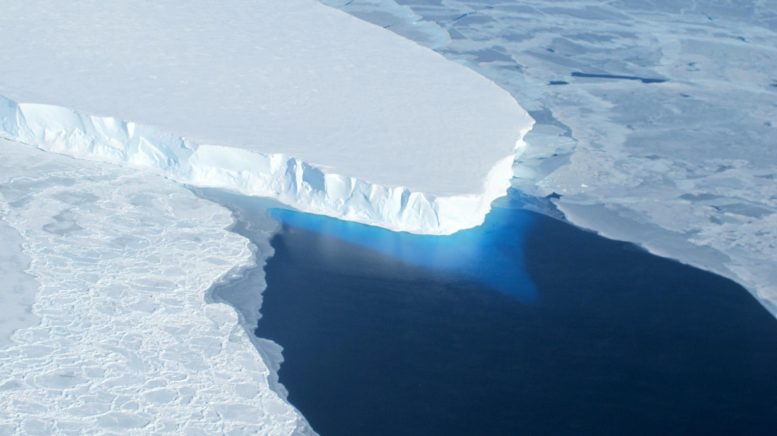
New observations reveal that warm seawater is flowing beneath Antarctica’s Thwaites Glacier, potentially accelerating catastrophic sea level rise within the next decade. Researchers are using advanced satellite imagery and modeling to study these changes, which could have severe consequences for global coastal regions. Credit: NASA
Satellite data provides the first evidence of warm ocean water intrusion beneath Antarctica’s Thwaites Glacier.
For the first time, visible evidence has been captured showing warm seawater pumping beneath Antarctica’s Thwaites Glacier, known as the Doomsday Glacier. It earned this ominous nickname because of its massive size and the significant role it plays in global sea level rise. Its potential to rapidly disintegrate and melt could lead to catastrophic increases in sea levels worldwide, posing a serious threat to coastal regions and low-lying areas.
An international team of scientists observed it using satellite imagery and warned that it could accelerate catastrophic sea level rise in 10 to 20 years. The researchers, including a scientist from the University of Waterloo, published their findings on May 20 in the Proceedings of the National Academy of Sciences (PNAS).
Impacts of Seawater Intrusion
The intrusion of seawater causes the ice to continuously lift off the land and settle back down again. Ice melts intensely when it first touches seawater, and because Thwaites Glacier measures about 75 miles (120 kilometers) wide by 0.75 miles (1.2 kilometers) deep, this effect could lead to devastating sea level rise. The glacier is situated in a basin. To date, the ocean water has only touched the rim of it. However, the researchers predict it may only take 10 to 20 years before the glacier retreats into the deeper part of the basin, at which point glacier melt will likely speed up even more.
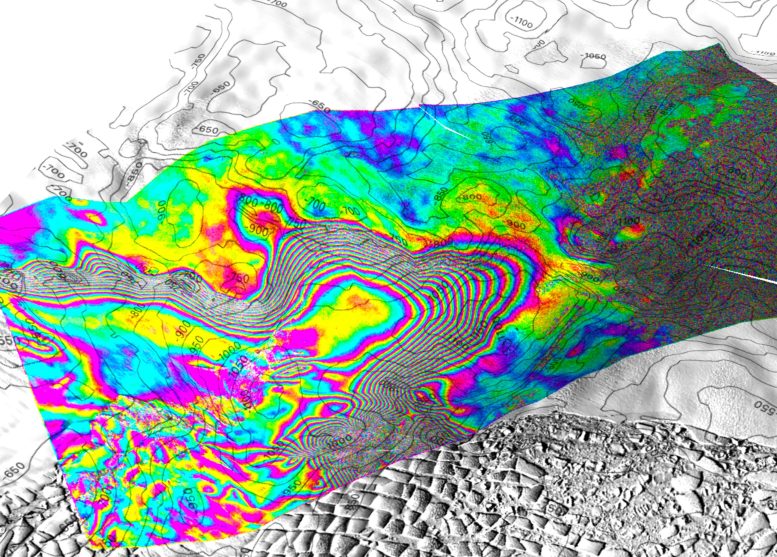
Screen shot of a 3D view of the tidal motion of Thwaites Glacier, West Antarctica recorded by the ICEYE Synthetic Aperture Radar (SAR) constellation based on images acquired on May 11, 12, and 13, 2023. Contour levels are bed topography contours at 50 m interval. Each interferometric fringe color cycle is a 360-degree change in phase, equivalent to a 1.65 cm displacement in line-of-sight distance of the ice surface. The interferogram is overlaid on a Landsat 9 image acquired in February 2023. In this study, we show that the limit of tidal flexing varies by kilometers over the tidal cycle, indicating that pressurized seawater is able to intrude beneath grounded ice over kilometers and set vigorous heat exchange with the glacier base. On the right side of the screen, a separate bull’s eye pattern indicates seawater intrusion propagating another 6 km beyond a protective ridge, indicating that the glacier retreat is still ongoing, at a kilometer per year in this critical sector of Antarctica. Credit: Eric Rignot / UC Irvine
Concerns Over Rapid Changes
“Thwaites is the most unstable place in the Antarctic and contains the equivalent of 60 centimeters of sea level rise,” said Dr. Christine Dow, a professor in the Faculty of Environment at the University of Waterloo, and a co-author of the study. “The worry is that we are underestimating the speed that the glacier is changing, which would be devastating for coastal communities around the world.”
The world has already felt the social and economic consequences from a couple of centimeters of sea level rise. However, the researchers note that the sea level rise of an additional half-meter or more will gravely impact populations in many low-lying areas like Vancouver, Florida, Bangladesh, and low-lying Pacific islands, such as Tuvalu and the Marshall Islands.
Technological Advances in Research
To detect seawater intrusion and assess its impacts, researchers utilized ICEYE DInSAR satellite data and subglacial water modeling. Dow and her team at Waterloo are currently working on creating new models that consider the impact of ocean water flowing into the basin and subglacial water flowing out and mixing with ocean water to accurately predict how fast the glacier will melt.
Research and Adaptation Challenges
“At the moment we don’t have enough information to say one way or the other how much time there is before the ocean water intrusion is irreversible,” said Dow, who is also the Canada Research Chair in Glacier Hydrology and Ice Dynamics. “By improving the models and focusing our research on these critical glaciers, we will try to get sea level rise estimates at least pinned down for decades versus centuries. This work will help people adapt to changing ocean levels along with focusing on reducing carbon emissions to prevent the worst-case scenario.”
Dr. Eric Rignot, lead author and professor of Earth system science at the University of California, Irvine (UC Irvine) hopes these results will lead to increased support for research examining the changes taking place beneath glaciers in Antarctica.
“There is a lot of enthusiasm from the scientific community to go to these remote, polar regions to gather data and build our understanding of what’s happening, but the funding is lagging,” said Rignot, who is also affiliated with the Jet Propulsion Laboratory at the California Institute of Technology. “We operate at the same budget in 2024 in real dollars that we were in the 1990s. We need to grow the community of glaciologists and physical oceanographers to address these observation issues sooner rather than later, but right now we’re trying to climb Everest in tennis shoes.”
For more on this research, see Satellites Reveal “Vigorous Melting” Beneath Antarctica’s Thwaites Glacier.
Reference: “Widespread seawater intrusions beneath the grounded ice of Thwaites Glacier, West Antarctica” by Eric Rignot, Enrico Ciracì, Bernd Scheuchl, Valentyn Tolpekin, Michael Wollersheim and Christine Dow, 20 May 2024, Proceedings of the National Academy of Sciences.
DOI: 10.1073/pnas.2404766121
Dow and Rignot collaborated with researchers at UC Irvine and ICEYE. The study, “Widespread seawater intrusions beneath the grounded ice of Thwaites Glacier, West Antarctica,” appears in Proceedings of the National Academy of Sciences (PNAS).


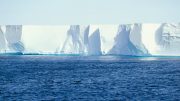
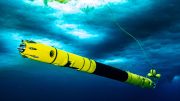




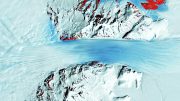
These elite scientists need to justify their high wages and great lifestyles and so they create these scenarios. They are not objective at all. They create a theory and then go out to try and prove it while the rest of us have to pay for it. Climate change is a normal and natural process that has been happening since the planet formed. There is nothing we can do to stop it. And we are not the cause.
There’s truth to this!!! If our government would get their priorities straight instead of giving money to Ukraine to mention one. Put these moneys into the research needed for our Lives!!! Yes quit blaming the people. This is real.
(1) That part of the Thule glacier that is floating will NOT rise the sea levels. That part of the glacier on land may.
(2) That entire side of Antarctica where the Thule glacier sits is atop a whole ridge of volcanoes. All though the volcanoes are not active today ( i.e. erupting) those volcanoes provide a significant and ling term heat source.
Have these scientists, or any scientists, conducted any in depth research in how these volcanoes are attributing to the Thule Glacier melt?
The method is this; scare people and get money. Try heating a bathtub full of cold water by waving a hair dryer at it.
Our squidgy planet is massaged and has its shape changed by forces due to orbital variation. See sub- sea hydrothermal vents. Approx 70% of active volcanoes are sub-sea. Sub-sea crust is thinner than continental crust and has a lot of cracks in it. e.g. see “Pacific Ring of Fire” and then look up a table of specific heat capacities and compare water with air. Seismic activity leads increases in ocean temperature, and air temperature lags ocean temperature. The Western Antarctic is a highly active fault zone and geothermal flux region. CO2 is plant food. 97% of climate scientists are anxious about the future of their funding.
This isn’t up to the average citizen or fossil fuel companies. It is the property insurance companies, their underwriters, and mortgage investors that will analyze scientific information and adjust their premiums and rates, or even refuse coverage or financing, as already happens. In this sense, insurance companies and investors are to some degree protecting the public from misinformation. Clearly there are financial interests that want this problem to go away. Again, what happens is not up to them.